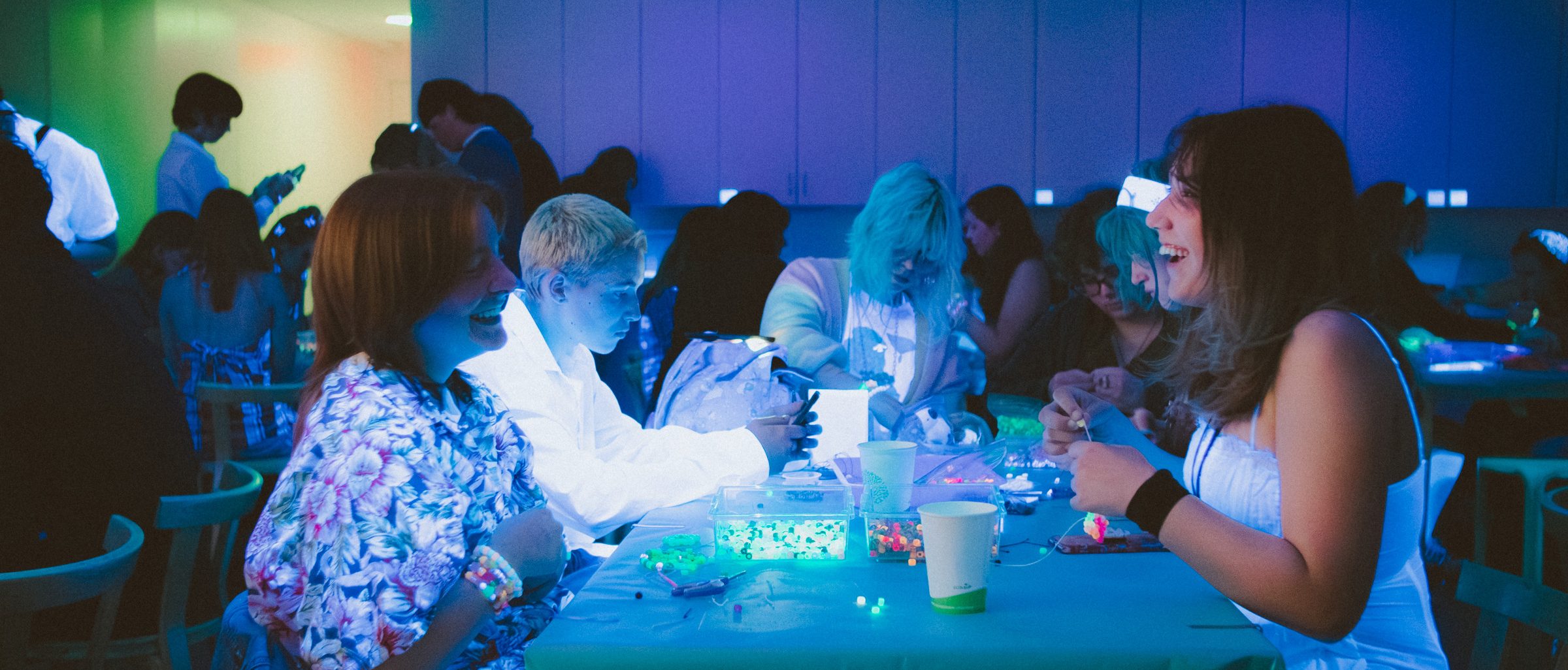Learning

The Walker’s Public Engagement, Learning & Impact (PELI) department centers learning for everyone, at any age.
The Walker’s Public Engagement, Learning & Impact (PELI) department centers learning for all. Translating complex ideas into accessible programming, PELI serves as the bridge between the Walker’s curatorial programs and the broader community.
Every year, PELI presents lectures, workshops, and participatory events designed to bring contemporary art into conversation with contemporary life. From art-making activities to social gatherings, the PELI team partners with artists and community members to create new opportunities for public engagement. Among the program’s most popular offerings are school and tour programs, as well as Free Thursday Nights, Free First Saturdays, and Sensory Friendly Sundays. For high school and middle school students, the department also runs youth-specific programming, including the celebrated Walker Art Center Teen Arts Council (WACTAC).
Inspired by experimental pedagogies and community feedback, PELI serves upwards of 120,000 individuals annually across museum-, school-, and community-based settings.
To find out how to bring PELI programs to your school or community, email tours@walkerart.org or access@walkerart.org, or call 612-375-7564.
In 1940 the Walker Art Center opened with an announcement to visitors: “Welcome, we have tried to make our galleries friendly, inviting, and instructive.” With this statement, the Walker’s educational foundation began. In addition to informational labels for artworks and helpful staff to answer questions, the Walker opened an art school in 1940. With the assistance of the Works Progress Administration, local artists taught classes in sculpture, design, drawing, and other disciplines. Classes were available for children and adults. The Walker Art School, under the direction of artist Mac Le Sueur, lasted until the early 1950s.
In the 1950s and 1960s, Walker education shifted to lectures and workshops for adults and children and eventually grew to engage artists in projects with students. For example, in 1966 while exhibiting works as part of the Walker’s exhibition Eight Sculptors: The Ambiguous Image, the artist Christo, together with Minneapolis College of Art (now the Minneapolis College of Art and Design) students, created Balloon Ascension. Also in the 1960s, the Walker sponsored summer art workshops for high school students who studied with visiting artists, such as Benjamin Leroy Wigfall, a painter, printer, and educator, in 1969.
As education programming grew, so did the department. In 1984, a wing of the expanded Walker Art Center was dedicated for education, including an ArtLab where kids could create at tables and chairs sized for them. To celebrate the new wing, education director Adam Weinberg organized Artfest, a festival of performances for and by kids. As part of ArtFest, Weinberg brought graffiti artist Keith Haring for a Walker residency. Haring worked with schoolchildren to create sets for the production Rompin and Stompin in the Underground. During his brief stay, Haring gave a lecture about his work and painted a mural in the upper concourse between the Walker and the Guthrie Theater.
Continuing to focus on adult and children’s programming, in 1992 Walker started Free First Saturdays (FFS). Designed for families, FFS provides art-making activities and events free of charge each first Saturday of the month. With the success of Free First Saturday, additional free programming was added, including Free Thursday Nights and Sensory Sundays. In 1994 with a grant from the Lila Wallace Reader’s Digest Foundation, the Walker began a teen program. Expanding on the workshop model of the 1960s, high school students worked with artists in residence, including Dawoud Bey in June 1995 in conjunction with his exhibition, Portraits: 1975–1995. Teens also explored the Walker’s permanent collection and wrote labels on individual works. Their investigation became a documentary, The Listening Project: “Over a four-month period, 15 teenagers from six Twin Cities high schools explored the Walker and its permanent collection, interviewed staff members, and ‘listened’ to what artworks have to say, resulting in a video that captures the varied responses that contemporary art can elicit from adolescents. In 1995 The Listening Project won the prestigious Muse Award from the American Association of Museums (AAM).”
After the Walker’s campus expanded in 2005, an innovative approach to education called Open Field began. This experimental program provided the tools for people to gather and learn in an informal, unprogrammed way in the spirit of a town square. Using the outdoor space adjacent to the Walker, groups gathered to create art together, such as the Drawing Club. Open Field also presented artists in an informal setting with participants, such as the Futurefarmers project A People Without a Voice Cannot Be Heard, co-commissioned by Northern Lights in 2010. Presented on the hillside with a group of college students, designers, and other participants, it was a “temporary classroom investigating how voice is used as a tool for exchange and liberation.” (Open Field, page 153.)
Today, the Public Engagement, Learning, and Impact (PELI) department continues to experiment and expand arts education for all. To that end, PELI reaches more than 120,000 people per year at the museum and throughout the Twin Cities, and tirelessly seeks more ways to bring art to more people.
What is Contemporary Art?
Contemporary art is the art of now. It’s made by living artists—across disciplines, across mediums, across cultures—and it speaks to the complexity of our world in real time. Sometimes it’s political. Sometimes intensely personal. Sometimes it’s a giant blue rooster. Or a set of instructions on a simple notecard.
Read more

Upcoming programs


